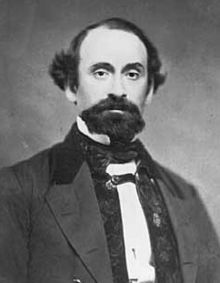John B. Sanborn
| John Benjamin Sanborn | |
|---|---|

John B. Sanborn, c. 1860
|
|
| Born |
December 6, 1826 Epsom, New Hampshire |
| Died | May 6, 1904 (aged 77) Saint Paul, Minnesota |
| Place of burial | Oakland Cemetery, Saint Paul, Minnesota |
| Allegiance |
United States of America Union |
| Service/branch |
United States Army Union Army |
| Years of service | 1861–1869 |
| Rank |
|
| Unit | Army of the Mississippi |
| Commands held | Department of Southwestern Missouri Department of Arkansas |
| Battles/wars | |
| Relations |
John B. Sanborn, Jr. (son) Walter H. Sanborn (nephew) |
John Benjamin Sanborn (December 5, 1826 – May 6, 1904) was a lawyer, politician, and soldier from the state of New Hampshire who served as a general in the Union Army during the American Civil War. He was also a key member of the postbellum Congressional-appointed Indian Peace Commission, which negotiated and signed several important treaties with native American tribes.
John B. Sanborn was born on a farm in Epsom, New Hampshire, on December 5, 1826. He was the youngest of five children of Deacon Frederick and Lucy L. (Sargent) Sanborn. He was educated at the Thetford Academy and the Pembroke Academy. He briefly attended Dartmouth College in 1851-52, but left after only one quarter to join the law office of Asa Fowler in Concord. He passed his bar exam in 1854 and subsequently moved to St. Paul, Minnesota, in December of that year. In partnership with two other men, he established a law firm in January 1855.
In March 1857, Sanborn married Catherine Hall. 1859, Sanborn was elected as a Republican to the Minnesota House of Representatives for a term, and then was elected to the Minnesota State Senate in 1861. His wife died in 1860.
In April 1861 Sanborn was appointed as the state's Adjutant General. His duties included overseeing the organization and equipping of three regiments of volunteer infantry for the fledgling Union army. He became the colonel of the 4th Minnesota Infantry in December 1861. The regiment had been mustered into Federal service by companies at Fort Snelling between October 4 and December 23. Sanborn and his men moved to Benton Barracks in St. Louis, Missouri, on April 23, 1862. Sanborn led the 1st Brigade, 7th Division of the Army of the Mississippi in the Battle of Iuka and then in Maj. Gen. Henry Wager Halleck's Siege of Corinth, Mississippi, from May 18 to May 30 of that year.
...
Wikipedia
